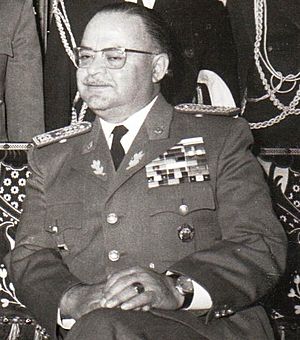Guillermo Rodríguez (politician) facts for kids
Quick facts for kids
Guillermo Rodríguez
|
|
|---|---|

Rodríguez in 1973
|
|
| Acting President of Ecuador | |
| In office 15 February 1972 – 11 January 1976 |
|
| Preceded by | José María Velasco Ibarra |
| Succeeded by | Alfredo Poveda |
| Personal details | |
| Born | 4 November 1923 Pujilí, Cotopaxi, Ecuador |
| Spouse | |
| Children | 5 |
| Alma mater | School of the Americas |
| Signature | |
| Military service | |
| Allegiance | |
| Branch/service | |
| Commands | Ecuadorian Army |
| Battles/wars | El Carnavalazo coup |
Guillermo Antonio Rodríguez Lara (born 4 November 1923) is a former political and military leader from Ecuador. He was the leader of Ecuador from 1972 to 1976. He became leader after a military takeover in 1972. This event removed President José María Velasco Ibarra from power. Rodríguez Lara described his government as "revolutionary and nationalistic," meaning it aimed for big changes and focused on Ecuador's own interests.
Contents
Early Life and Military Career
Guillermo Rodríguez Lara was born in Pujilí, Cotopaxi, Ecuador, on 4 November 1923. He trained at the School of the Americas in Panama. There, he learned about military planning, special warfare, and managing equipment.
Becoming Ecuador's Leader
As the commander of the Ecuadorian Army, Rodríguez Lara played a key role in a military takeover in 1972. This event, sometimes called "El Carnavalazo," led to President José María Velasco Ibarra being sent away to Argentina. After this, Rodríguez Lara became the new leader of Ecuador.
Time as Leader of Ecuador
During his time as leader, Ecuador's economy grew a lot. This was mainly because oil prices increased around the world. The money from oil helped his government start many public projects.
Building for the Future
His administration used the oil money to build important things for the country. These projects helped improve life for many people in Ecuador.
- They built new hospitals to help people get better medical care.
- New schools were constructed, giving more children places to learn.
- Roads were improved, making travel easier. A notable project was paving the road between Quito and Tulcán.
- An oil refinery was built in Esmeraldas. This allowed Ecuador to process its own oil.
- New equipment was bought for the armed forces.
Challenges and End of Leadership
In 1975, some military officers tried to remove him from power, but their attempt was not successful. However, the Ecuadorian military eventually removed him from power in January 1976.
Later Life and Legacy
Guillermo Rodríguez Lara turned 100 years old on 4 November 2023. As of July 2025, he is one of the oldest living former state leaders in the world.
External links
- Official Website of the Ecuadorian Government about the country President's History: http://www.presidencia.gob.ec/modulos.asp?id=28/
| Political offices | ||
|---|---|---|
| Preceded by José María Velasco |
President of Ecuador 1972–1976 |
Succeeded by Alfredo Poveda |
See also
 In Spanish: Guillermo Rodríguez Lara para niños
In Spanish: Guillermo Rodríguez Lara para niños

